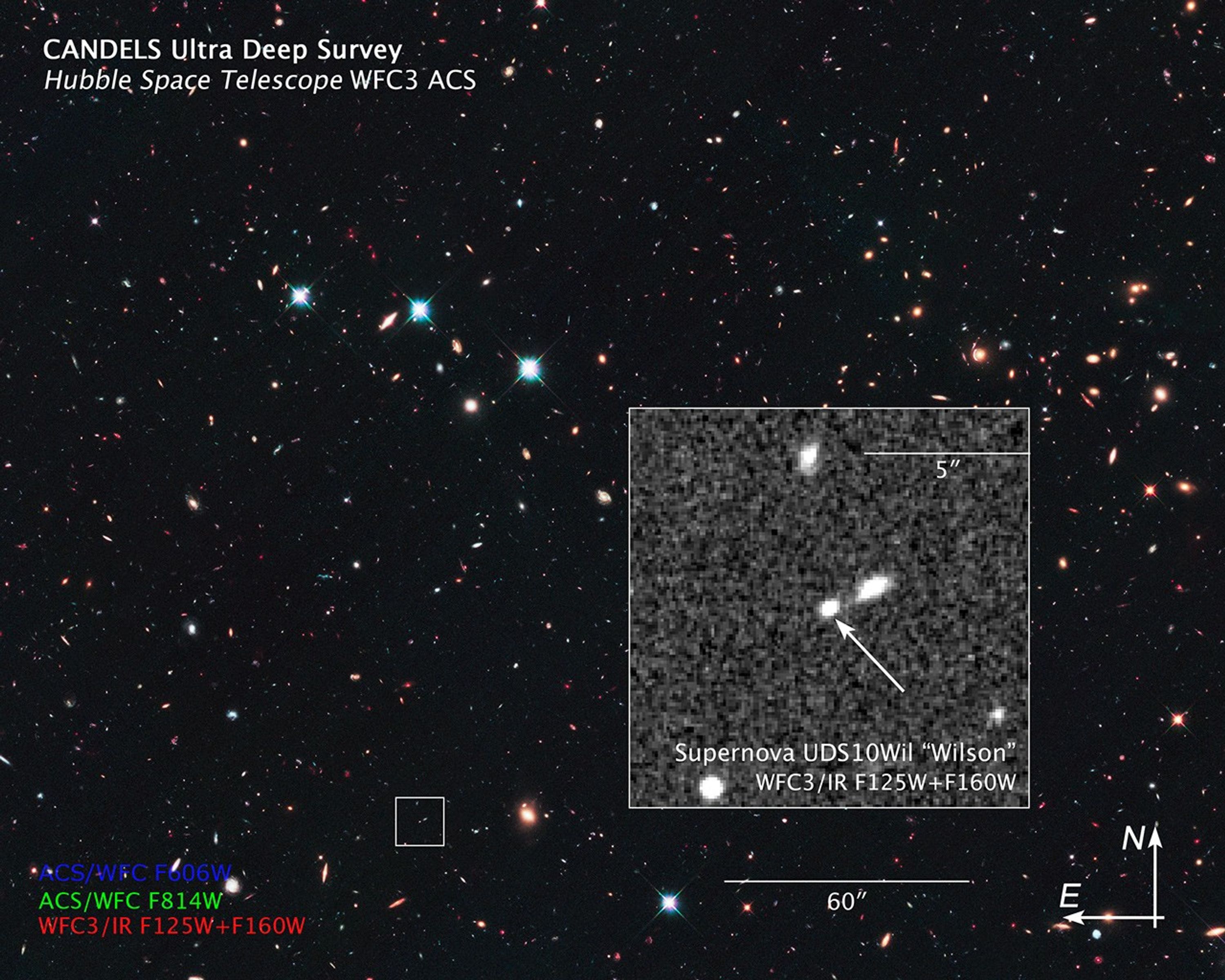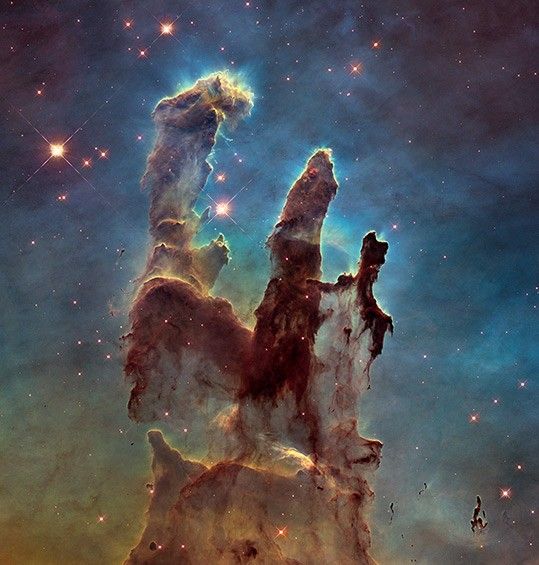NASA's Hubble Space Telescope has broken the record in the quest to find the farthest supernova of the type used to measure cosmic distances. Supernova UDS10Wil, nicknamed SN Wilson, after the 28th U.S. President, Woodrow Wilson, exploded more than 10 billion years ago (redshift 1.914). At that time, the universe was in its early formative years where stars were being born at a rapid rate.
SN Wilson belongs to a special class called Type Ia supernovae. These bright beacons are prized by astronomers because they provide a consistent level of brightness that can be used as a cosmic yardstick for measuring the expansion of space. They also yield clues to the nature of dark energy, the mysterious force accelerating the rate of expansion.
"The new distance record holder opens a window into the early universe, offering important new insights into how these stars explode," said astronomer David O. Jones of The Johns Hopkins University in Baltimore, Md., lead author on the science paper detailing the discovery. "At that epoch, we can test theories about how reliable these detonations are for understanding the evolution of the universe and its expansion."
One of the debates surrounding Type Ia supernovae is the fuse that ignites them. This latest detection adds credence to one of two competing theories of how they explode. Although preliminary, the evidence favors the explosive merger of two burned-out stars, called white dwarfs.
The discovery was part of a three-year Hubble program, begun in 2010, to survey faraway Type Ia supernovae to determine if they have changed over the 13.8 billion years since the big bang, the explosive birth of the universe. Called the CANDELS+CLASH Supernova Project, the census uses the sharpness and versatility of Hubble's Wide Field Camera 3 (WFC3) to assist astronomers in the search for supernovae in near-infrared light and verify their distance with spectroscopy. The survey searches for supernovae in two large Hubble programs, the Cosmic Assembly Near-infrared Deep Extragalactic Legacy Survey and the Cluster Lensing and Supernova Survey with Hubble, which study thousands of galaxies. The census is led by Adam Riess of the Space Telescope Science Institute in Baltimore, Md., and The Johns Hopkins University.
Finding remote supernovae provides a powerful method to measure the universe's accelerating expansion due to dark energy. So far, Riess's team has uncovered more than 100 supernovae of all types and distances, ranging from 2.4 billion years ago to more than 10 billion years ago. Of those new discoveries, the team has identified eight Type Ia supernovae that exploded more than 9 billion years ago, including SN Wilson.
The supernova team's search technique involved taking multiple near-infrared images spaced roughly 50 days apart over the span of three years, looking for a supernova's faint glow. The team spotted SN Wilson in December 2010 in the CANDELS survey. They then used WFC3's spectrometer and the European Southern Observatory's Very Large Telescope to verify the supernova's distance and to decode its light, finding the unique signature of a Type Ia supernova.
Though SN Wilson is only four percent farther than the previous distance record holder, it pushes roughly 350 million years further back in time. The last record breaker was announced just three months ago by a separate team led by David Rubin of the U.S. Department of Energy's Lawrence Berkeley National Laboratory in California.
"These supernovae are important tools for studying the dark energy that is speeding up the expansion of space," Riess explained. "This study gives us a chance to 'stress test' the supernovae themselves to test how well we understand them."
Astronomers, however, still have much to learn about the nature of dark energy and how Type Ia supernovae explode.
"The Type Ia supernovae give us the most precise yardstick ever built, but we're not quite sure if it always measures exactly a yard," said team member Steve Rodney of The Johns Hopkins University. "The more we understand these supernovae, the more precise our cosmic yardstick will become."
By finding Type Ia supernovae so early in the universe, astronomers can distinguish between two competing explosion models. In one model the explosion is caused by a merger between two white dwarfs. In another, a white dwarf gradually feeds off its partner, a normal star, and explodes when it accretes too much mass.
The team's preliminary evidence shows a sharp decline in the rate of Type Ia supernova blasts between roughly 7.5 billion years ago and more than 10 billion years ago. The steep drop-off favors the merger of two white dwarfs because it predicts that most stars in the early universe are too young to become Type Ia supernovae.
"If supernovae were popcorn, the question is how long before they start popping?" Riess said. "You may have different theories about what is going on in the kernel. If you see when the first kernels popped and how often they popped, it tells you something important about the process of popping corn."
In the two white-dwarf scenario, the first supernovae pop off about 400 million years after they are born as stars, and then the rate gradually declines over time. "There is a cosmic 'high noon' for star formation at about 10 billion years ago," Rodney explained. "If most of the supernovae were exploding very shortly after their birth, then we would see a cosmic 'high noon' for supernova explosions at about the same time. We are actually finding relatively few supernovae like SN Wilson at the time of peak star formation, and this favors the double white-dwarf model, with a modest time delay between formation and explosion."
Knowing the type of trigger for Type Ia supernovae will also show how quickly the universe enriched itself with heavier elements, such as iron. These exploding stars produce about half of the iron in the universe, the raw material for building planets and life.
The team's results have been accepted for publication in an upcoming issue of The Astrophysical Journal.




































